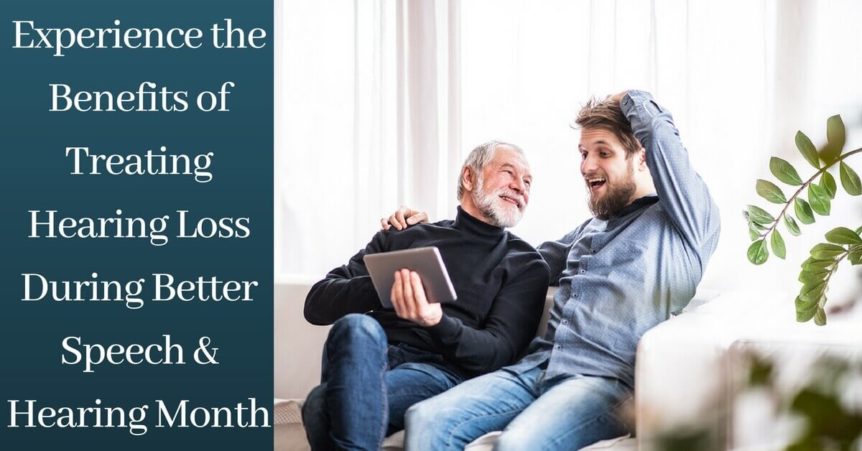- The Harm of Smoking to the Ears - April 9, 2025
- The Importance of Exercise for Hearing Health - March 11, 2025
- Movie Theaters and Hearing Aids - February 13, 2025
The American Speech Language Hearing Association (ASHA) raises awareness around hearing loss and communication disorders every May. This year, ASHA’s theme is “Communication for All,” with the focus on how hearing loss affects people of all age groups. We take a look at the benefits of treating hearing loss across all ages.
Hearing Loss in Older Americans
Hearing loss is the third most common medical condition affecting Americans, especially in the 65 and older age group. One in three people over 65 experience hearing loss, while 50% of people over 75 experience some degree of hearing loss. Recent studies have indicated that hearing loss is often undiagnosed and undertreated among older people, which leads to a number of issues.
Hearing happens in the brain, so when hearing loss goes untreated, it can affect our cognitive abilities. Researchers at Johns Hopkins University have published a number of studies linking untreated hearing loss and an increased risk for dementia. Because hearing happens in the brain, muffled sound signals make it difficult for your brain to process audio information, making it work harder to make sense of sound. At the same time, the cognitive processes reserved for other functions are diminished. As a result, people with untreated hearing loss may also experience memory and concentration problems.
A recent article from The New York Times discusses the link between hearing loss and falls and accidents. Difficulties with processing sound in your surroundings could lead to a disconnect that affects you physically.
Hearing Loss in the Workforce
Approximately 60% of people in the American workforce experience some degree of hearing loss. Additionally, 60% of service people returning from combat zones report cases of hearing loss and tinnitus, due to exposure to loud sounds in the field.
Hearing loss could have detrimental effects in the workplace. When communication is important in almost every industry, hearing loss breaks down this process and makes it difficult to recognize speech. Furthermore, hearing loss interferes with your concentration and productivity. People with untreated hearing loss have been found to earn less than colleagues with normal hearing and colleagues who treat their hearing loss with the use of hearing aids.
That’s right – while many people may feel anxiety about the taboo of treating hearing loss with the use of hearing aids, in fact hearing aids help people perform better on the job!
Additionally, it is important to note that workplace noise is a leading cause for hearing loss. If you work in an industry that is loud, consider getting hearing protection if your employer does not provide it. Custom ear protection goes a long way to protect your hearing from noise-induced hearing loss.
Hearing Loss Among Infants and School-Age Children
In the first week of Better Speech and Hearing Month, ASHA is raising awareness around hearing loss and communication disorders in infants and school-age children. Because hearing loss is often relegated to older populations, hearing loss is not often thought of as an issue that appears in young people. In fact, hearing loss may affect anyone at any age.
ASHA points to the fact that parents are often not aware of the issue of hearing loss and communication disorders in their children. Indeed, this comes as no surprise because hearing loss is an invisible condition. In their press release for Better Speech and Hearing Month, ASHA says, “According to the poll of more than 1,100 ASHA members—audiologists and speech-language pathologists—the number one barrier to early identification of communication disorders is lack of awareness about the warning signs among parents (46% said this was the case). A full 69% say parents of young children are not aware of the early warning signs of speech/language disorders—and 32% say that, on average, the symptoms of hearing loss are going undetected in children for 1 year or longer.”
Furthermore, ASHA President Elise Davis-McFarland notes, “Communication disorders are among the most common childhood disabilities—and they are highly treatable in most cases. Yet even with all of the information available to today’s parents, our members report they are still seeing children much later than what is optimal for achieving the best outcome. We know parents want the best for their children. However, they may hear messages that encourage a ‘wait and see’ approach by suggesting a child may grow out of a communication issue. Unfortunately, this often is not the case. Delaying treatment means children may miss a critical developmental window where they acquire a majority of their foundational speech and language skills, which occurs between birth and 3 years of age.”
Hearing Testing at Better Hearing Center
The first step to identifying hearing loss is taking a hearing test. For Better Speech and Hearing Month, why not take the opportunity to get your hearing tested? Whatever your age and hearing abilities, there is a treatment available for you. Contact us at Better Hearing Center today.

